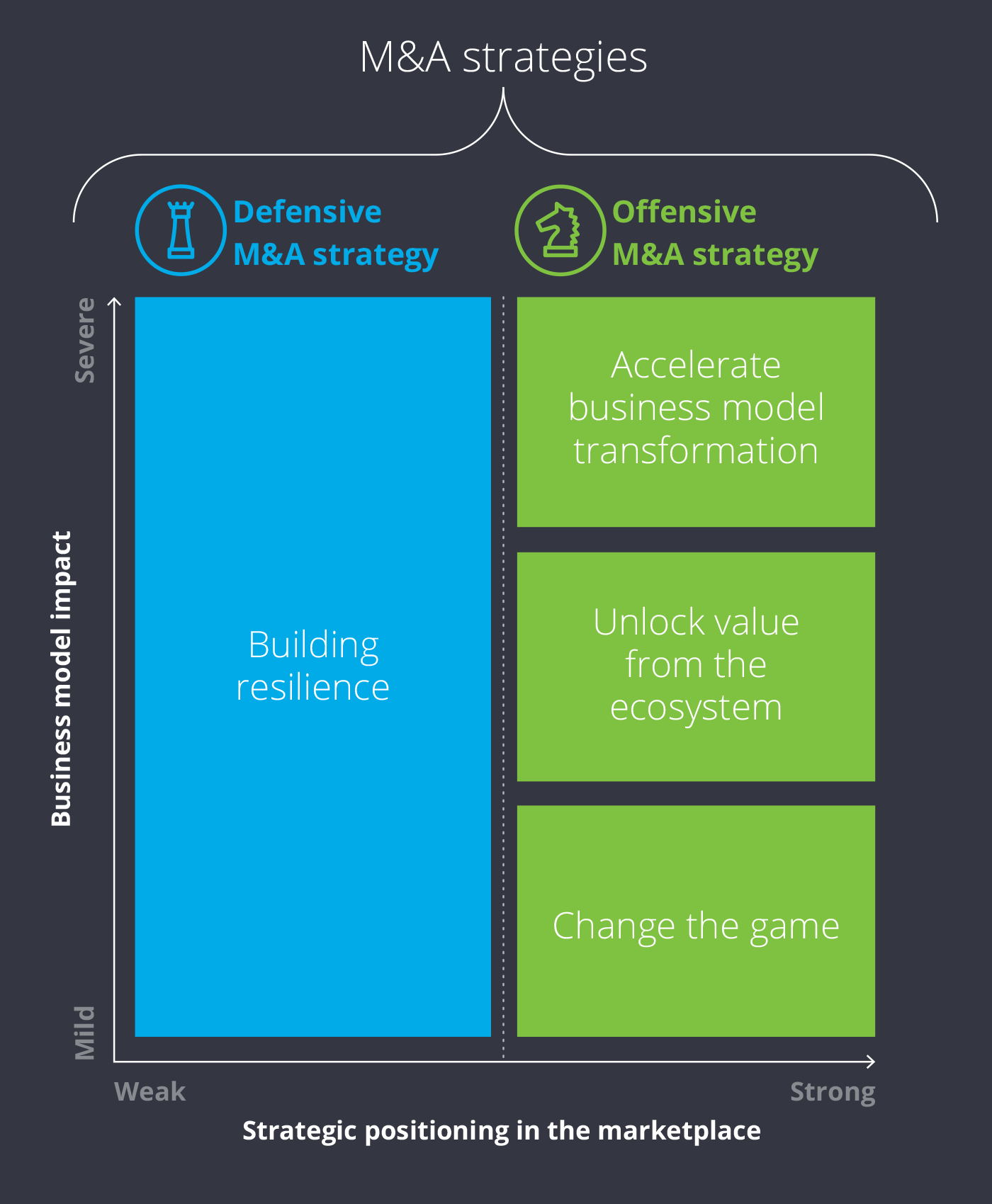How M&A can shake up and stabilize businesses
In the face of seismic changes, it’s easy to feel unmoored—and a global pandemic can certainly breed uncertainty. Even so, corporations and private equity firms spent an unprecedented $5 trillion on mergers and acquisitions in 2021. Perhaps the way to stay afloat in a sea of change is by working together.

The past and the present
Mergers and acquisitions (M&A) have been a powerful tools in business to expand capabilities and remain viable, which we discussed in our previous report released at the onset of the pandemic. We believed that recovery would be asymmetrical and that sectors would have to reinvent themselves. We imagined that mergers and acquisitions would be a key part of those efforts—and they were, to the tune of $5 trillion spent on M&A activities in 2021.
This makes sense in the context of a crisis. A company’s actions during a crisis can be broken into three stages: responding, recovering, and thriving. Transformation and M&A were key parts of many companies’ response and recovery strategies, and we believe M&A could also help to determine whether companies will thrive.
Part of what is useful about M&A strategies is that they give companies an avenue to complete a broad set of goals even as they navigate previously uncharted paths. We may be living in a post-pandemic world, but global conflict, climate change, technology shifts, and other trends will continue to test business models across different sectors.
Based on our research from the original "Charting new horizons" report, we’ve developed an M&A framework based on defensive and offensive deal archetypes that could build resilient business models and accelerate transformation.
This makes sense in the context of a crisis. A company’s actions during a crisis can be broken into three stages: responding, recovering, and thriving. Transformation and M&A were key parts of many companies’ response and recovery strategies, and we believe M&A could also help to determine whether companies will thrive.
Part of what is useful about M&A strategies is that they give companies an avenue to complete a broad set of goals even as they navigate previously uncharted paths. We may be living in a post-pandemic world, but global conflict, climate change, technology shifts, and other trends will continue to test business models across different sectors.
Based on our research from the original "Charting new horizons" report, we’ve developed an M&A framework based on defensive and offensive deal archetypes that could build resilient business models and accelerate transformation.

Defense and offense
Resilience isn’t about simply being able to weather changes. A different form of resilience may prioritize being agile and adaptable, which can be difficult to focus on when merely focusing on survival. A defensive M&A strategy can help to build this resilience in a few ways: delivering value, optimizing portfolios, and strengthening positioning.
For example, supply chain issues have been a recurring challenge in the past couple of years. To address that, a company could consider an acquisition of a supplier. This happened recently in response to the global semiconductor chip shortage crisis. A major chipmaker acquired a specialist chip contract manufacturer to boost production capacity and secure its customer base.
Companies could also seize on opportunities through co-investment and partnerships, including with private equity firms. This kind of collaboration can facilitate transformation by pooling resources and expertise, which in turn helps to build resilience.
Similarly, offensive strategies are also a way to capitalize on opportunities. However, an offensive strategy is grounded in gaining momentum rather than building resilience. Corporations could do that by transforming business models, collaborating to stay competitive, and capitalizing on cross-sector convergence. Many opportunities nowadays need to be considered through the lens of whether to build, buy, or collaborate to achieve a goal. These dynamics have pushed the expansion of the scope of traditional M&A strategies to include collaborative structures, partnerships, and other configurations.
For instance, ESG (environmental, social, and governance) goals often can’t be achieved unilaterally and demand collaboration; it can take multiple collaborators to make an impact. A useful example of this is the decarbonization of the aviation industry. To tackle this goal, an aircraft manufacturer, industrial gas supplier, and airport operator formed an alliance to promote the use of hydrogen infrastructure. Although this isn’t necessarily an example of a traditional merger or acquisition, it captures the positive potential of this broadened vision of M&A.
For example, supply chain issues have been a recurring challenge in the past couple of years. To address that, a company could consider an acquisition of a supplier. This happened recently in response to the global semiconductor chip shortage crisis. A major chipmaker acquired a specialist chip contract manufacturer to boost production capacity and secure its customer base.
Companies could also seize on opportunities through co-investment and partnerships, including with private equity firms. This kind of collaboration can facilitate transformation by pooling resources and expertise, which in turn helps to build resilience.
Similarly, offensive strategies are also a way to capitalize on opportunities. However, an offensive strategy is grounded in gaining momentum rather than building resilience. Corporations could do that by transforming business models, collaborating to stay competitive, and capitalizing on cross-sector convergence. Many opportunities nowadays need to be considered through the lens of whether to build, buy, or collaborate to achieve a goal. These dynamics have pushed the expansion of the scope of traditional M&A strategies to include collaborative structures, partnerships, and other configurations.
For instance, ESG (environmental, social, and governance) goals often can’t be achieved unilaterally and demand collaboration; it can take multiple collaborators to make an impact. A useful example of this is the decarbonization of the aviation industry. To tackle this goal, an aircraft manufacturer, industrial gas supplier, and airport operator formed an alliance to promote the use of hydrogen infrastructure. Although this isn’t necessarily an example of a traditional merger or acquisition, it captures the positive potential of this broadened vision of M&A.
Disruption and you
The geopolitical tensions and economic challenges of the past few years will likely continue to affect how people do business. But change has always been a catalyst for opportunity, and M&A activities can facilitate transformative change. By building resilience and momentum, mergers and acquisitions can give businesses a chance to face the unknown with the tools to thrive.
Sector M&A pathways
Check out M&A activity across sectors in 2021
